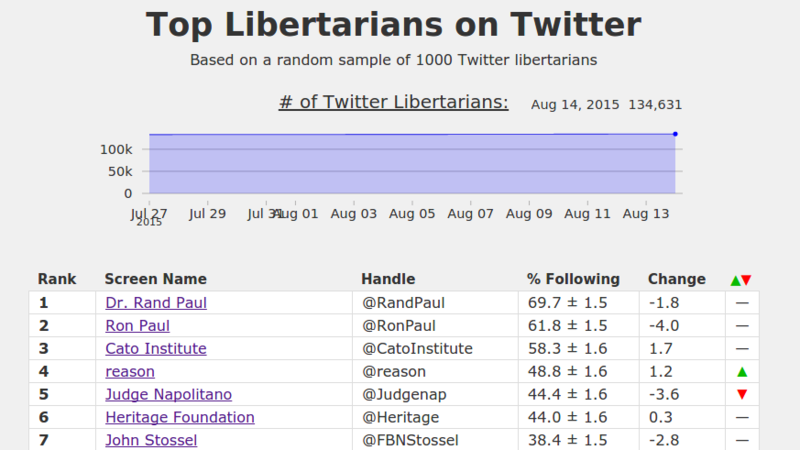Who are Twitter's top libertarians?

About 70% of Twitter libertarians follow Senator Rand Paul, according to samples I’ve been collecting, making him the top libertarian on Twitter. Next are Ron Paul (about 63%), the Cato Institute (56%), Reason magazine (48%), and Judge Napolitano (46%).
To find Twitter libertarians, I rely on the statistical finding that Twitter users tend to follow accounts that reflect their own ideologies. (See paper 1, paper 2) So I put together a list of 22 popular libertarian Twitter accounts, and downloaded lists of their followers from the Twitter API. If a person follows 3 or more of the accounts, I assume that he or she is a libertarian.1
From the resulting list of Twitter libertarians— more than 134,000 at last count— I randomly select 1000 to see who they’re following. Interested readers can view the results at willonrails.com/top_libertarians.2, 3, 4
Although I usually focus on the more radical elements of the libertarian movement, the beltway libertarians— that is, the relatively moderate libertarians who work on or write about policy for a living, often in the “beltway” of Washington, D.C.— dominate the top of the list, along with some Fox News hosts and conservative Twitter accounts. Of the more radical, openly anarchist libertarians, Adam Kokesh, known for promoting a “final American Revolution,” is the most popular with 14% of libertarians following his account. Jeffrey Tucker, a much nicer anarchist, comes next at 9%. Stefan Molyneux, an anarchist and Men’s Rights Activist who describes himself as the “greatest philosopher alive,” exerts a smaller influence at about 6%.
I plan to update this every Friday evening, with the hope that other interested researchers and I can use this data to test hypotheses about how ideological groups evolve over time. (But no guarantees!) Are libertarian extremists becoming more or less influential in the movement? How does Twitter popularity change in response to economic or other social conditions? I keep wishing I had some data on this, so now I’m making some.
Technical notes:
-
The list of accounts is RonPaul, RandPaul, CatoInstitute, reason, ThomasEWoods, jeffreyatucker, StefanMolyneux, bryan_caplan, sfliberty, mises, FreeStateNH, c4ssdotorg, lewrockwell, GovGaryJohnson, RoderickTLong, BobMurphyEcon, LPNational, FreeTalkLive, Antiwarcom, AynRandInst, AynRandOrg, ErikVoorhees
To some extent the selection of these accounts is arbitrary and reflects my interests in certain subgroups in the libertarian movement. A different set of accounts would produce slightly different results.
-
Since the raw results include a lot of newspapers, Fox News hosts, and other accounts I don’t care about, I had to find a way to automatically remove them. Step 1 was to only include accounts contained in my list of Twitter libertarians. (I made exceptions for John Stossel and the ACLU, who somehow were not in the list.) Even after this, there were still a lot of irrelevant accounts. In the end I imposed a second restriction– that the account must be followed by at least 7 (32%) of the original 22 accounts. Apparently the 22 popular libertarian Twitter accounts follow many of the accounts that I’m interested in, and relatively few non-libertarian accounts.
The result is a list of accounts favored by the libertarian “elite,” along with their popularity among the libertarian masses. It’s not a perfect list– Wikileaks and the ACLU were, sadly, removed, along with some others who should be included, and some accounts that I’m not interested in remain on the list. I’ll probably tinker with this some more to get better results.
-
The ± numbers are estimates of the 95% confidence interval. I’m deriving these numbers from a formula from D. S. Sivia, “Data Analysis: A Bayesian Tutorial,” p. 22. The estimates may not work well for accounts with few followers.
-
The R code I’m using to collect and analyze the data can be found on Github.